Personalities from French history receiving the most attention from doll crafters appear to be Napoleon and the women swirling around th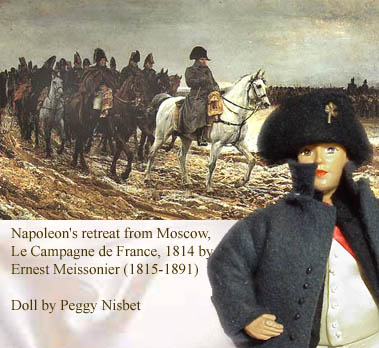 e court of Louis XVI, especially Marie Antoinette.
e court of Louis XVI, especially Marie Antoinette.
The Napoleonic Era - At least two different versions of Napoleon were created by Peggy Nisbet. I have Napoleon in his redingote - a greatcoat worn by Napoleon during his famous retreat from Moscow in the brutal winter of 1812. Napoleon was known to have had six of these greatcoats in his wardrobe, two gray, two green, and two blue. I was fortunate to see one of his actual gray greatcoats in the Napoleon exhibit at the Memphis (Tennessee) International Culture Center in July of 1993. That coat was willed to his son, the Duke of Reichstadt.
Madame Alexander portrayed Napoleon in the uniform of a colonel of the grenadiers a pied of the Imperial Guard. Napoleon often wore either this uniform or the uniform of a colonel of the chasseurs a cheval. 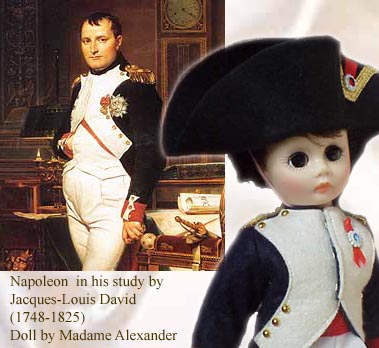
Only six such uniforms survived to the present day, four chasseur and two grenadier. I viewed one of his uniforms of the chasseurs a chevel of the Imperial Guard included in the same exhibit in Memphis. It was taken to Saint Helena when Napoleon was exiled to the island and given by the Emperor to the Mameluke Ali who served him during his exile. Ali subsequently bequeathed the uniform along with other memorabilia of the Emperor to the city of Sens.
I wish I could find a replica of Napoleon in his coronation robes. However, I'm sure I would have to pay much more than $30 - $40 for it - the average price of a Nisbet doll of him.
Since the only part of his coronation regalia that remains intact is the tunic, the gold-fringed silk sash and 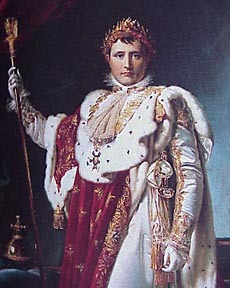 the sword that are displayed at the Chateau of Fontainebleau, I had to be satisfied with admiring only this oil portrait at the exhibit - "The Coronation Procession on the Pont-Neuf" by Jacques Bertaux.
the sword that are displayed at the Chateau of Fontainebleau, I had to be satisfied with admiring only this oil portrait at the exhibit - "The Coronation Procession on the Pont-Neuf" by Jacques Bertaux.
The only doll I have of his Empress Josephin e at present is a small costume doll produced by Rexard of Essex in England. Rexard costume dolls are made of lighter-weight plastic than Nisbet dolls and the fabrics they use are not equal in quality to the fabric used by Nisbet. But, they are nicely detailed and cost an average of only $8 - $12 each compared to $26 - over $100 for Nisbet models. I have only seen one Nisbet Josephine come up for bid and she was quickly bid out of my reach. Madame Alexander makes a Josephine but she looks so childish I didn't choose to bid on her.
e at present is a small costume doll produced by Rexard of Essex in England. Rexard costume dolls are made of lighter-weight plastic than Nisbet dolls and the fabrics they use are not equal in quality to the fabric used by Nisbet. But, they are nicely detailed and cost an average of only $8 - $12 each compared to $26 - over $100 for Nisbet models. I have only seen one Nisbet Josephine come up for bid and she was quickly bid out of my reach. Madame Alexander makes a Josephine but she looks so childish I didn't choose to bid on her.
Mattel made a bea utiful "Great Eras" Barbie dressed in a French Imperial gown. Although Barbie collectors tend to be a group of their own, I have found some of the Barbie period pieces to be quite nicely detailed with a commendable effort to be authentic. Notice the gowns of the Imperial ladies invited to the wedding of Napoleon and the Arch Duchess Marie-Louise of Austria from this painting by Georges Rouget (1784-1869). Barbie looks quite appropriately attired.
utiful "Great Eras" Barbie dressed in a French Imperial gown. Although Barbie collectors tend to be a group of their own, I have found some of the Barbie period pieces to be quite nicely detailed with a commendable effort to be authentic. Notice the gowns of the Imperial ladies invited to the wedding of Napoleon and the Arch Duchess Marie-Louise of Austria from this painting by Georges Rouget (1784-1869). Barbie looks quite appropriately attired.
In the 60s, the Empire waist dress came back into vogue. In fact, I fashioned my velvet wedding dress with an Empire waist when I married in 1968. I always thought it was a very flattering style.
The Bourbon court of the 1700s - The very first Nisbet doll that I purchased was a portrait doll of Louis XVI. He is in excellent condition and I won the bid at less than $30. It must have been beginner's luck since I have seen Nisbet Louis XVI dolls sell for much more since then.
Of Louis, Richard Hooker writes, " Louis ascended the throne at the age of twenty; he was of average intelligence, but was not overly concerned with the running of the country. Both the Seven Years War and the French support of the American Revolution had put France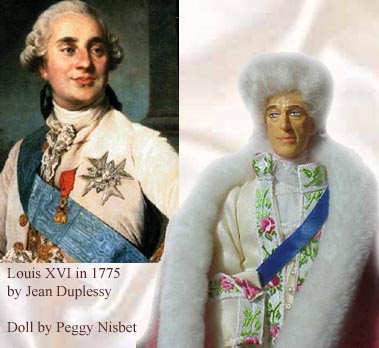 deeply in debt. Louis' chief financial officer was a man named Anne Robert Jacques Turgot (1727-1781), who was a brilliant and creative administrator. Turgot instantly set about trying to reform the country's financial situation by instituting a series of reforms that included replacing the corvée with a tax on landowners, an easing of guild laws to allow industrial manufacturing to increase, and, radically, a sharp cut in monarchical expenses. Had these reforms gone through, the Revolution probably would never have happened."
deeply in debt. Louis' chief financial officer was a man named Anne Robert Jacques Turgot (1727-1781), who was a brilliant and creative administrator. Turgot instantly set about trying to reform the country's financial situation by instituting a series of reforms that included replacing the corvée with a tax on landowners, an easing of guild laws to allow industrial manufacturing to increase, and, radically, a sharp cut in monarchical expenses. Had these reforms gone through, the Revolution probably would never have happened."
Much like the earlier system in the Roman Empire, taxes were collected by private businessmen. Hooker explains, "They would loan the taxes to the government and then collect the taxes directly; they then paid themselves both the principal and the interest on the loan and sent the rest to the government. They were, of course, free to withhold as much as they wanted, so the Third Estate was paying far more in taxes than actually went to the government." The reforms proposed by Turgot were vetoed by the Parlements, made up largely of nobility who would have to pay the new tax. The resulting financial crisis precipitated a steep inflationary rise in prices. "This inflation was good news for French manufacturing and mercantilism," Hooker explains, because it resulted in a significant shot of capital into emerging industrial and mercantile businesses. It played hell, however, with the peasantry. Not only did the peasants have to pay higher prices for the basics of life (the peasants lived in a subsistence economy only), but landlords began raising fees on the peasantry when they saw their purchasing power decrease. By 1789, over 80 percent of an average peasant's household income went to purchasing bread alone—just bread. In that same year, unemployment in many parts of France was over 50%."
Although Louis was my very first Nisbet doll, it took me quite a while and a number of losses before I finally snagged a Nisbet Queen Marie Antoinette for him. It'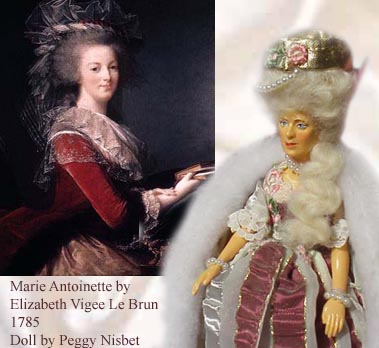 s not that there were few opportunities but she is a popular subject among collectors and it took me a while before one came up with the costume I wanted (the pink velvet cape actually matches the one worn by Louis) for the price I wanted to pay.
s not that there were few opportunities but she is a popular subject among collectors and it took me a while before one came up with the costume I wanted (the pink velvet cape actually matches the one worn by Louis) for the price I wanted to pay.
"The life of Marie Antoinette was the stuff of dreams when she was married at age 15 to the crown prince of France, the dauphin," writes Axel Antoinette, "France was then the most powerful nation of continental Europe, and the royal palace at Versailles the most opulent. The young princess could hardly have hoped for a more prestigious marriage and her magnificent marriage ceremony in 1770 was unmatched in royal pageantry."
"But, Louis was homely, awkward and hardly her heart's desire. His devotion to the hunt, clocks and his workshop and his early hours were in contrast to her pursuit of the arts, fashion, dance and French nightlife. Marie Antoinette sought escape from her marital frustration and the boredom of court life. Time went by and she began to exercise power as queen, Marie Antoinette spent less time at court, and surrounded herself with a dissolute clique, led by Yolande de Polignac and Thérèse de Lamballe. She lavished expensive gifts and positions upon these friends and in doing so ignored the great houses of the French nobility. The Queen spent lavishly on her dress and adornments. Each year she exceeded her clothing allowance which the King covered. The excessive fashions for high headdresses, plumes and voluminous dresses were subject to public comment, caricature and on occasion ridicule. By the late 1780s, envy and hatred of Marie Antoinette were widespread. Many at court had always opposed the Austrian alliance, and had resented her efforts to intercede on occasion for Austrian causes."
Elizabeth Vigee Le Brun was Marie's court po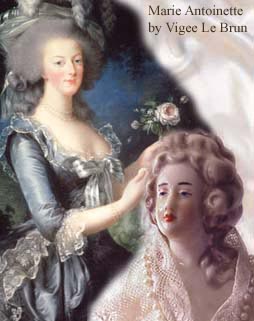 rtrait artist and captured the queen on canvas many times. Probably her most famous portrait is Marie Antoinette with a rose. I have two antique half dolls made into bedside lamps that could very well be Marie Antoinette. I purchased both of them at the local flea market. I purchased the smaller of the two from a very old lady who said she had had the nightlight ever since she was a child and was cleaning out her attic. I was so surprised (and pleased) that it didn't even have one
rtrait artist and captured the queen on canvas many times. Probably her most famous portrait is Marie Antoinette with a rose. I have two antique half dolls made into bedside lamps that could very well be Marie Antoinette. I purchased both of them at the local flea market. I purchased the smaller of the two from a very old lady who said she had had the nightlight ever since she was a child and was cleaning out her attic. I was so surprised (and pleased) that it didn't even have one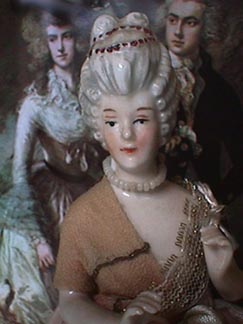 broken finger - quite a feat since both of the half-doll's hands are extended away from her body.
broken finger - quite a feat since both of the half-doll's hands are extended away from her body.
One of the few times I bid quite high for a portrait doll was on an auction for a Franklin Mint Marie Antoinette. She was absolutely exquisite but I gave up the bid at $231.
I was able to win the bid on Marin's interpretation of Marie Antoinette. Marin was a doll manufacturer located in Chiclana, Spain. The most common Marin figures depict Spanish dancers and bull fighters. The hair style and costume of the Marin Antoinette are quite detailed although she has the facial features and pose of the typical Marin flamenco dancers. Even though Marie was famed for her voluptuous bosom, I doubt that she would thrust it out as ostentatiously as the Marin doll. The gown looks similar to the fashion worn by Marie in the 1762 chalk portrait by J.E. Liotard.
I did buy two very small (4 1/2") celluloid dolls from a Fre nch vendor that appeard to be from the same historical period. The male doll was labeled "Jean Philippe" but the female was not labeled. She looks like she could be a Marie Antoinette. I was impressed with the detail of their hair and costumes as well as their delicate little open-and-close eyes.
nch vendor that appeard to be from the same historical period. The male doll was labeled "Jean Philippe" but the female was not labeled. She looks like she could be a Marie Antoinette. I was impressed with the detail of their hair and costumes as well as their delicate little open-and-close eyes.
I'm afraid I am not real familiar with that period of French history. Jean Philippe must have a connection to Marie Antoinette because I found another pair of French court dolls by artist Frances Maranuk distributed by Showstoppers that were also called Philippe and Antoinette. Although they had childlike faces, I appreciated the detail on their costumes, particularly the costume of Philippe. The brocade of the jacket is very beautiful and set off very nicely with a crocheted jabot and pearl faux buttons.
Two contemporaries of Marie Antoinette, Madame Pompadour, mistress of Louis XV (father of Marie's husband, Louis the XVI), and Madame Du Barry, Madame Pompadour's s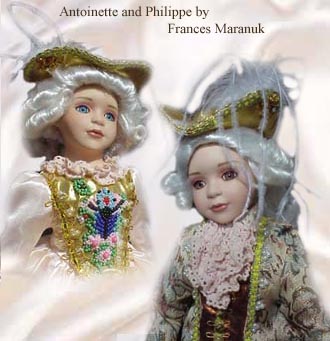 uccessor, are also favorite subjects of doll creators.
uccessor, are also favorite subjects of doll creators.
In the introduction to a novel by Nancy Mitford, Amanda Foreman writes, "Mme de Pompadour was born Jeanne-Antoinette Poisson. Her father had left the family in 1725, when she was four, to escape his creditors. Even though Jeanne-Antoinette grew up to be an accomplished beauty - well-read, musical, artistic, intelligent, and exceptionally graceful - her moderate birth and family history repelled suitors. Finally, her step-father bribed one of his own nephews to propose, using a generous marriage settlement as bait."
"Undaunted, the twenty-year-old Jeanne-Antoinette set about establishing herself in Parisian society. It was not always a dignified struggle, but the young woman was single-minded in her determination to gain admission to the Court. Obsessed by a gypsy's prophecy, she was already convinced of her love for the King. Moreover, she was certain that the reserved father of the ten would fall in love with her too. In 1744, the happy coincidence of a royal ball in Paris, and Louis XV finding himself in between mistresses, gave Jeanne-Antoinette her long-awaited opportunity. Within hours, the post of royal mistress had been filled."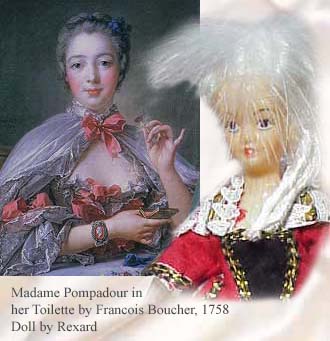
"The rules governing Versailles were too arcane for Jeanne-Antoinette to master over night. Like all closed societies, it thrived on nuances which are second nature to the initiated and hidden traps for the unwary. It was not only important for the Marquise to know how to behave in general, but also how to treat each inhabitant appropriately. Although she had conducted herself with aplomb the first time the King showed her off to the Court, the risk of ridicule was great. Every member of the Court was ready to pounce on some unintentional solecism. To remove the stain of her parentage, Louis XV created Jeanne-Antoinette the Marquise de Pompadour. To eradicate her bourgeois manners required more comprehensive measures. The King sent her to the country for several months to be trained by two of his closest friends. The Marquise was an enthusiastic pupil, and very quickly learned the complex customs and language of Versailles."
"The only area where the Marquise and the King differed was in their intellectual tastes. She had always admired the French Philosophes. Long before she had met the King, her friendships had extended to Voltaire as well the authors of the great Encyclopédie. When Louis XV banned its publication she persuaded him to allow private subscribers to receive t heir copies. However, he refused to read it. The Marquise had to be content with furthering the interests of the Philosophes on her own. Even Voltaire, who did nothing but complain, recognised her pure intentions. 'She had righteousness in her soul,' he wrote, 'and justice in her heart; all this is not to be met with every day.'"
Also of humble birth, Madame Du Barry, resumed the vacancy left in Louis XV's heart when Madame Pompadour died in 1764.
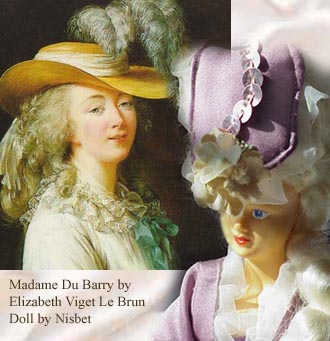 "Jeanne Becu was the illegitimate daughter of a woman from the Champagne region who had become a cook in Paris. After starting life as an assistant in a milliner's shop, Jeanne attached herself to a Gascon pimp and cardsharper, Comte Jean Du Barry, known from his large female entourage as "Mahomet". She spent four years working for Mahomet as a high-class expensive prostitute. Then she came to the notice of the King, lonely since the death of his mistress Madame de Pompadour (did not show in RoV). She had no conversation, nothing to recommend her but the bloom of youth and sexual expertise. The King ordered her to marry Comte Jean Du Barry, so that she could come to Court. Louis XV installed her in the late Queen's apartments."
"Jeanne Becu was the illegitimate daughter of a woman from the Champagne region who had become a cook in Paris. After starting life as an assistant in a milliner's shop, Jeanne attached herself to a Gascon pimp and cardsharper, Comte Jean Du Barry, known from his large female entourage as "Mahomet". She spent four years working for Mahomet as a high-class expensive prostitute. Then she came to the notice of the King, lonely since the death of his mistress Madame de Pompadour (did not show in RoV). She had no conversation, nothing to recommend her but the bloom of youth and sexual expertise. The King ordered her to marry Comte Jean Du Barry, so that she could come to Court. Louis XV installed her in the late Queen's apartments."
Marie Antoinette's first reaction to her was, "it is pitiable to see the weakness he (the King) has for Madame du Barry, who is the silliest and most impertinent creature imaginable." Madame Du Barry did offer her help, however, when the Queen was later arrested during the French Revolution. Eventually, when Du Barry herself was arrested by the French Republic and accused of selling arms to enemies of the French Republic, she followed Marie Antoinette to the guillotine.
Dolls of the French Court
from Mary's
Historical Doll Collection and exhibits I have seen